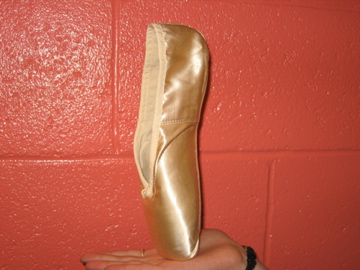Marie Taglioni is often given the credit, and the blame, for being the first dancer to rise all the way to the tips of her toes and dance “en pointe.” Appropriately, she was dancing the role of a sylph in “La Sylphide” and the shoes allowed her to give the illusion of hovering as though she were weightless (Barringer & Schlesinger, 2004). To look at the origin of modern pointe shoes, though, we must step back even further, to the beginnings of ballet.
Classical ballet as we know it today originated in France from court dances imported from Italy in the 17th century. King Louis XIV is remembered by ballet historians as an avid dancer and he opened the Academie Royale de Danse to train dancers. Dance steps, in particular the five positions, began to be codified at this time. Going quickly through 200 years of history, we see that between the time the Academie Royale de Danse opened and Taglioni performed La Sylphide, ballet transitioned from being a men’s dance form to having many notable female dancers. The aesthetic also changed from a more grounded style to the airy, ethereal quality of the Romantic era, and it is this aesthetic, at its peak, that gave rise to the idea of pointe shoes (Barringer & Schlesinger, 2004, http://www.the-perfect-pointe.com/PointeHistory.html).
In their article “Technique and Autonomy in the Development of Art: A Case Study in Ballet”, Sandra N. Hammond and Phillip E. Hammond (1989) walk us through a model for understanding the development of dance technique. They suppose four influencing factors:
1. Any technical innovation is partly the result of earlier techniques.
2. Any technical innovation is partly the result also of dissatisfaction with prevailing practices.
3. Dissatisfaction with prevailing practices, however, is partly the result of technical innovation.
4. Dissatisfaction results also from a range of non-technical factors.
From these, they trace a web through five major stages of ballet development, explaining each in terms of an interaction of the four influences. At each of these stages, one major technical development occurred, and this both allowed for and encouraged later changes. For example, stage 3 marks the first time that maximum turnout, the external rotation of the legs, was considered important. This had the effect of realizing motions that had previously been physically impossible (factor 1). Range of motion in the hips was particularly affected by increased turnout, as was the strength of certain leg muscles requiring more extensive training. This in turn allowed for the creation of more difficult steps, particularly turns and jumps which would have been impossible without turnout (factors 2 and 3). Hammond points out that physical abilities were not all that influenced these developments, though. She suggests that shifts in cultural ideals changed what types of ballets were being created (factor 4). A change from classicism to romanticism across the arts changed the styles of choreography.
We can use the Hammonds’ model not just to understand development in movement, but also to trace a non-technical factor, dress code, that piggybacks with changes in movement. These changes ultimately leads to the invention of pointe shoes. As technique changed, women shortened their dresses so as not to hinder their movement, and to show off their legs, which were doing increasingly intricate and complicated steps. Women also stopped wearing high-heeled shoes, but continued to rise up on their toes, to demi-pointe, or half pointe. As choreography demanded the floating quality associated with the romantic ballets, rising to full pointe was the next logical step, at which point technical development converged with technological development.
Early pointe shoes did not have the structure and strength of modern shoes, but instead were just ballet slippers heavily reinforced with darning and stitching around the toes. This meant that dancers relied primarily on their own strength and were unable to balance on pointe for extended periods of time. The next developments, during the 19th century, were a sturdier box around the toes, as well as a stronger sole. The platform of the shoe, upon which the dancer stands, became wider, making it easier to balance by distributing weight across a larger area. The 20th century was marked by modifying the shape of shoes to make them more ergonomic and, as always, facilitate new developments in technique. Pointe shoes are still constantly evolving, as new materials, particularly synthetics, are introduced (Barringer & Schlesinger, 2004; http://www.the-perfect-pointe.com/PointeHistory.html).

